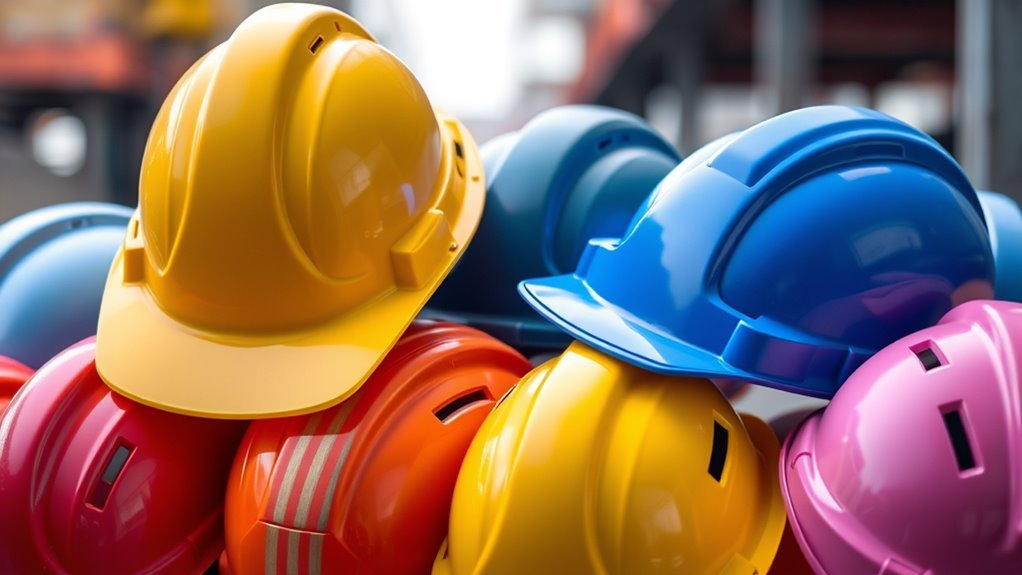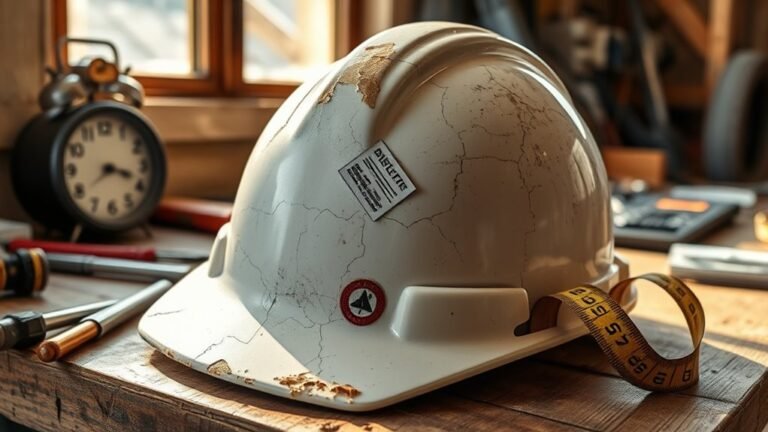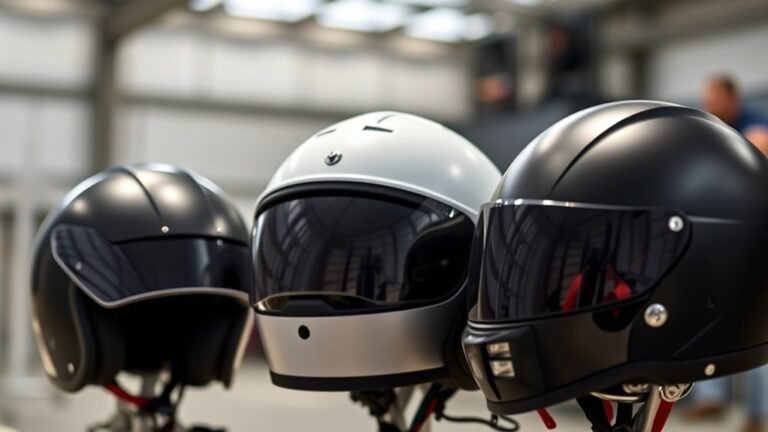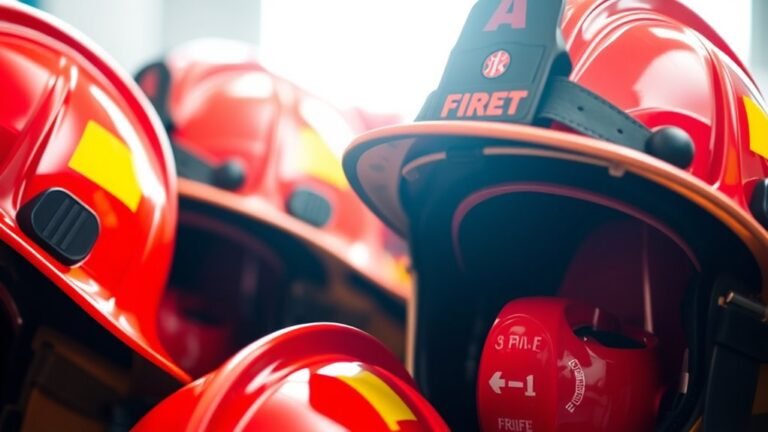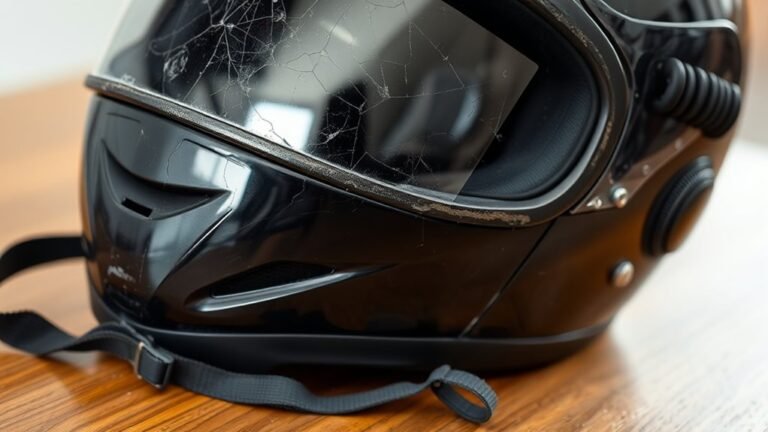Types of Hard Hats and Their Uses
There are several types of hard hats designed for specific safety needs. Type I hard hats provide top impact protection, ideal for construction and manufacturing. Type II hard hats offer lateral impact protection, perfect for environments with side hazards. Full brim hard hats extend coverage to the neck and ears, while ventilated options enhance comfort in hot conditions. Specialty hard hats cater to unique applications. Each type guarantees safety and compliance in its respective environment, and there’s much more to contemplate.
Overview of Hard Hat Standards
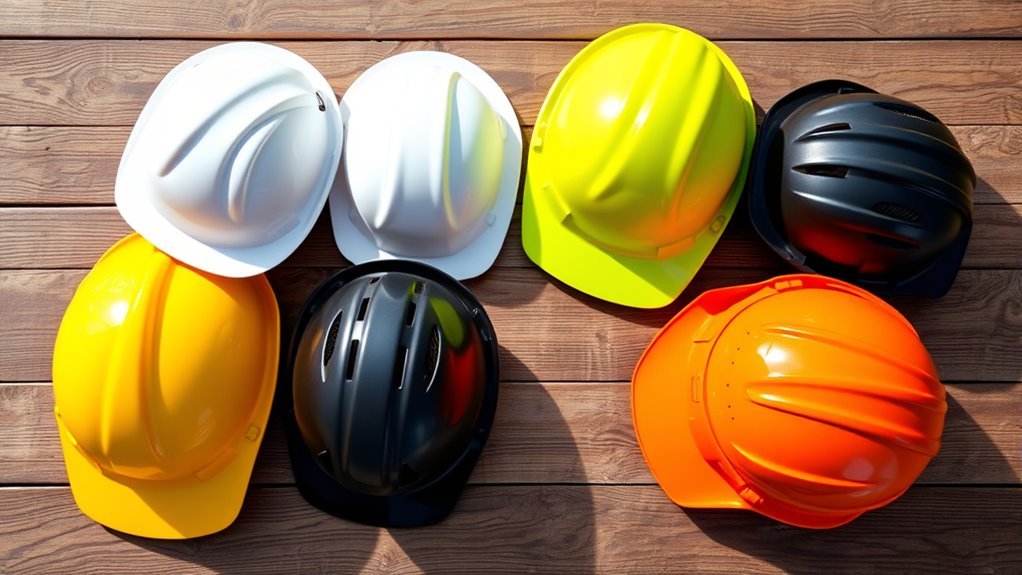
When you’re working in environments with potential head hazards, understanding hard hat standards is essential for your safety. Hard hat regulations set forth by organizations like ANSI and OSHA dictate the performance, testing, and certification requirements for protective helmets. These regulations guarantee that hard hats undergo rigorous evaluations to meet specific impact resistance and electrical protection criteria. You’ll want to verify that your hard hat has the appropriate hard hat certification, confirming compliance with these standards. Knowing the classifications—Type I and Type II—can further guide your selection process. By adhering to these regulations, you empower yourself to work with greater freedom, knowing you’ve chosen the right safety gear to protect your head from potential injuries in hazardous environments.
Type I Hard Hats: Top Impact Protection
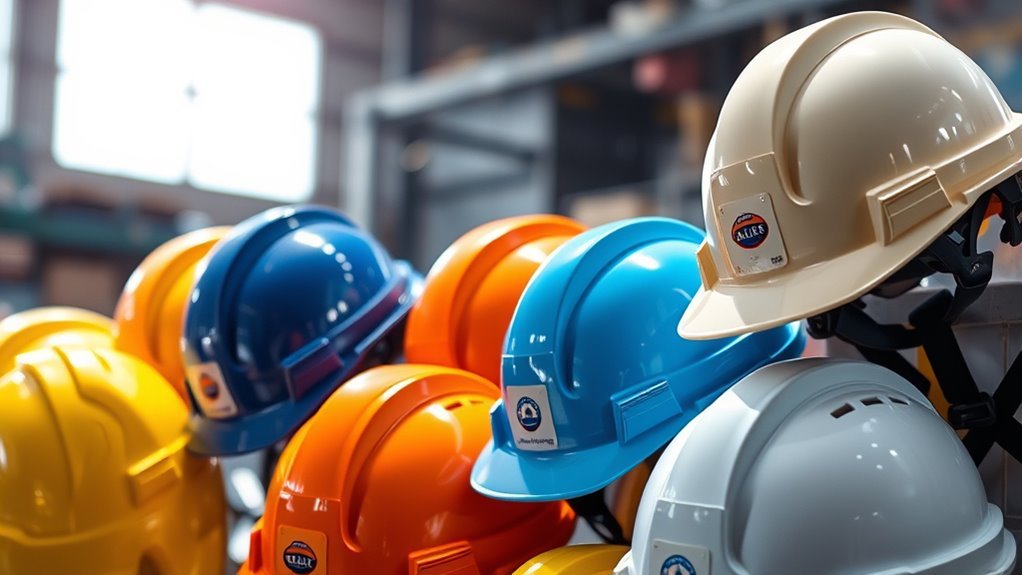
Type I hard hats are specifically designed to provide top impact protection, primarily from vertical impacts. They comply with stringent safety standards, ensuring reliability in hazardous environments. You’ll often find these hard hats used in construction, manufacturing, and other industries where overhead hazards are prevalent.
Design and Structure
Hard hats designed for top impact protection, classified as Type I, feature a robust structure specifically engineered to safeguard the head from falling objects and impact from above. These hard hats incorporate advanced hard hat materials like high-density polyethylene (HDPE) and fiberglass, ensuring durability without compromising weight. Design innovations, such as a reinforced shell and shock-absorbing liners, further enhance protection by dispersing energy from impacts. The suspension system inside the hard hat allows for a secure fit, which is vital for comfort during long hours of wear. Additionally, ventilation features can improve airflow, making them suitable for various work environments. Overall, the design and structure of Type I hard hats prioritize safety while considering the wearer’s freedom of movement and comfort.
Safety Standards Compliance
Although safety is paramount in many industries, hard hats classified as Type I must meet stringent safety standards to assure maximum protection against top impacts. These safety regulations guarantee that you’re adequately protected while working in hazardous environments. Here are the key compliance requirements for Type I hard hats:
- Impact Resistance: They must withstand a specific force to prevent injury from falling objects.
- Electrical Insulation: Certain models provide protection against electrical hazards, assuring your safety in electrical work zones.
- Durability Standards: Type I hard hats are rigorously tested for materials and construction, enhancing their lifespan and reliability.
Common Use Cases
In construction sites and industrial settings, the need for top impact protection is essential, making Type I hard hats a common choice for workers. These hard hats are designed to protect against falling objects, ensuring safety in high-risk environments. You’ll find them available in various hard hat materials, such as fiberglass and high-density polyethylene, each offering distinct benefits. Additionally, they come in an array of hard hat colors, allowing for easy identification and compliance with site-specific safety regulations.
| Hard Hat Material | Common Colors | Use Cases |
|---|---|---|
| Fiberglass | Yellow, White | Construction Sites |
| HDPE | Orange, Blue | Warehouses |
| Polycarbonate | Red, Green | Industrial Facilities |
Type II Hard Hats: Lateral Impact Protection
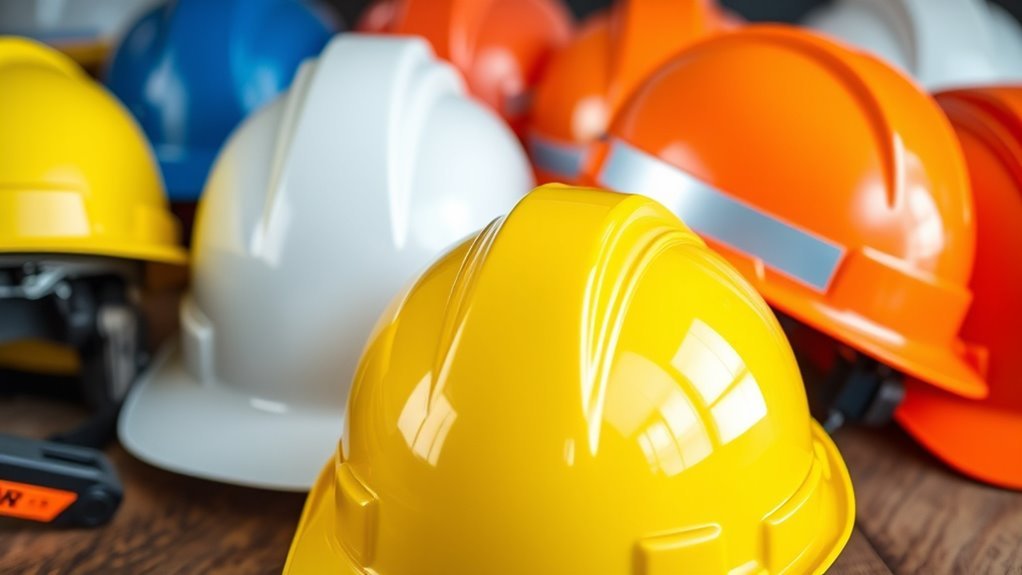
When working in environments where lateral impacts are a risk, understanding the importance of Type II hard hats is vital. These helmets offer specific design features that make them suitable for protecting against lateral impacts, which can occur from falling objects or collisions. Here’s what sets them apart:
- Side Protection: Enhanced coverage on the sides of the helmet provides significant defense against lateral impacts.
- Impact-Resistant Materials: Constructed from durable materials, they guarantee maximum protection while maintaining comfort.
- Adjustable Fit: Many Type II hard hats come with adjustable suspension systems, allowing for a secure and personalized fit.
Full Brim Hard Hats: Enhanced Coverage
Full brim hard hats provide superior protection compared to standard hard hats, especially in environments where exposure to falling debris and UV rays is a concern. The full brim design extends around the entire hat, offering additional coverage that protects your neck and ears from sunlight and potential impacts. One of the key full brim benefits is enhanced sun protection, making these hats ideal for outdoor work sites where prolonged sun exposure can lead to heat stress and skin damage. Additionally, the added shade helps improve visibility, reducing glare when working under bright conditions. By choosing a full brim hard hat, you’re investing in safety, comfort, and protection from the elements, allowing you to focus on your tasks with confidence.
Cap Style Hard Hats: Lightweight and Comfortable
Cap style hard hats are designed for those who prioritize lightweight comfort without compromising safety. These hard hats offer several cap style benefits that make them a popular choice among workers. Here are three key advantages:
- Lightweight Materials: Typically made from high-density polyethylene (HDPE) or fiberglass, these materials guarantee durability without the bulk.
- Comfortable Fit: The design allows for better ventilation and a snug fit, minimizing fatigue during long hours on the job.
- Versatile Use: Ideal for various industries, from construction to manufacturing, cap style hard hats adapt well to different work environments.
Choosing the right cap style materials is essential for maintaining safety while enjoying the freedom of movement and comfort you need on the job.
Electrical Hard Hats: Protection Against Electrical Hazards
When working in environments with electrical hazards, using an electrical hard hat is vital for your safety. These hard hats come with specific insulation ratings and shock protection features designed to reduce the risk of electrical injuries. It’s important to understand proper usage guidelines to guarantee maximum protection while on the job.
Electrical Insulation Ratings
Electrical insulation ratings are essential for hard hats designed to protect against electrical hazards. These ratings guarantee you’re equipped for electrical safety in various work environments. When selecting a hard hat, consider the following:
- Dielectric Rating: Indicates the voltage level the hard hat can withstand during insulation testing, typically rated at 2,200V or 20,000V.
- Material Composition: High-quality hard hats are made of non-conductive materials like fiberglass or plastic to prevent electrical conduction.
- Certification Standards: Look for compliance with ANSI/ISEA Z89.1 or similar standards to verify the hard hat meets safety regulations.
Shock Protection Features
Protecting against electrical hazards is essential in many industries, and hard hats with shock protection features play an important role in ensuring safety. These hard hats utilize advanced shock absorption techniques to dissipate energy from impacts, reducing the risk of head injuries. The incorporation of impact resistance materials, such as high-density polyethylene or fiberglass, enhances their durability, ensuring they can withstand harsh conditions. When selecting a hard hat, look for models specifically designed for electrical work, as they often meet stringent safety standards. By understanding the importance of shock protection features, you can make informed choices that safeguard your well-being while maintaining the freedom to work confidently in hazardous environments. Always prioritize protection when exposed to electrical risks.
Proper Usage Guidelines
To guarantee maximum safety while working in environments with electrical hazards, it is crucial to follow proper usage guidelines for electrical hard hats. Here are some key practices to guarantee your hard hat remains effective and extends its lifespan:
- Inspect Regularly: Check for cracks, dents, or signs of wear. Any damage can compromise your protection.
- Clean Properly: Use mild soap and water to clean your hard hat. Avoid harsh chemicals that may degrade materials.
- Store Correctly: Keep your hard hat away from direct sunlight and extreme temperatures. Proper storage helps maintain its integrity and performance.
Ventilated Hard Hats: Breathability and Comfort
How can you stay cool and comfortable while working in hot environments? Ventilated hard hats are designed specifically for this purpose. They incorporate breathable materials that allow air to circulate, helping to regulate your body temperature. This airflow not only enhances comfort but also aids in sweat management, reducing moisture buildup on your skin.
When you choose a ventilated hard hat, you’re not just selecting a safety tool; you’re investing in your well-being. These hard hats often come with adjustable features, allowing you to customize the fit for maximum comfort. Whether you’re on a construction site or working outdoors, the right ventilated hard hat can make a significant difference in maintaining focus and productivity while ensuring your safety.
Specialty Hard Hats: Unique Applications
While standard hard hats provide essential protection in many workplaces, specialty hard hats are tailored for unique applications that require additional features or capabilities. These hard hats are designed with unique materials and technologies to meet specific needs, ensuring you’re protected in specialized environments. Here are three types:
- Electrician Hard Hats: Made with non-conductive materials to prevent electrical hazards.
- Heat-Resistant Hard Hats: Crafted from specialized materials that withstand high temperatures, ideal for foundries and welding.
- Cooling Hard Hats: Equipped with built-in ventilation or cooling technologies, perfect for hot outdoor environments.
Choosing the right specialty hard hat enhances your safety and comfort, allowing you to focus on your work without worrying about potential risks.
Hard Hat Accessories: Enhancing Safety and Functionality
Hard hat accessories play an essential role in enhancing both safety and functionality on the job site. By incorporating visors and face shields, hearing protection accessories, and helmet liners, you can greatly improve your protection against various hazards. Understanding these accessories will help you make informed choices for ideal safety in your work environment.
Visors and Face Shields
Visors and face shields are essential accessories that enhance the functionality and safety of hard hats in various work environments. By incorporating these accessories, you can better protect yourself from hazards like flying debris, chemicals, and harmful UV rays. Here are some key points to reflect on:
- Visor Types: Options include clear, tinted, and anti-fog visors, each catering to specific visibility needs.
- Face Shield Applications: Ideal for welding, grinding, or chemical handling, face shields offer full-face protection while allowing for visibility.
- Easy Attachment: Most visors and face shields can be easily attached to hard hats, making them convenient for daily use.
Hearing Protection Accessories
When working in environments with high noise levels, incorporating hearing protection accessories into your hard hat system is essential for safeguarding your auditory health. These accessories come in various hearing protection types, including earmuffs and earplugs, designed to reduce harmful noise exposure. Earmuffs fit securely over the ears, while earplugs can be conveniently inserted for a snug fit.
Helmet Liners and Pads
A well-fitted helmet liner or pad can greatly enhance the comfort and safety of your hard hat. These accessories are essential for improving your overall experience while working in demanding environments. Here are three key benefits:
- Helmet Comfort: A cushioned liner adapts to your head shape, reducing pressure points and enhancing wearability throughout long shifts.
- Moisture Control: Many liners feature moisture-wicking materials that help keep sweat at bay, ensuring you stay dry and focused on the task at hand.
- Impact Absorption: Quality pads can add an extra layer of protection, absorbing shocks from impacts and reducing the risk of injury.
Integrating helmet liners and pads into your safety gear can markedly improve your work performance and comfort.
Choosing the Right Hard Hat for Your Job
How can you guarantee that you’re selecting the right hard hat for your job? Start by identifying the specific hazards you’ll face. Different hard hat features, like ventilation or face shields, can enhance your comfort and protection. Make sure to check for safety certifications such as ANSI Z89.1, which confirms the hat meets industry standards. You also need to take into account the style; Type I helmets protect against impacts from above, while Type II offers lateral impact protection. Finally, verify the fit is snug but comfortable, as a proper fit is essential for effectiveness. By evaluating these factors, you’ll be empowered to choose a hard hat that not only meets your safety needs but also aligns with your work style.
Frequently Asked Questions
How Often Should Hard Hats Be Replaced?
You should replace hard hats every 2 to 5 years, depending on the manufacturer’s guidelines and the wear conditions. Regular inspections can help determine the replacement frequency; if you notice cracks, dents, or signs of deterioration, it’s time for a new one. Adhering to safety standards is essential for ensuring your protection on the job. Always prioritize your safety by staying updated on the lifespan and condition of your hard hat.
Are Hard Hats Adjustable for Different Head Sizes?
Yes, hard hats are adjustable for different head sizes. Most models come with internal suspension systems that allow you to customize the fit. This feature is vital for ensuring safety and comfort, as a well-fitted hard hat provides better protection against impacts. Safety regulations require that hard hats fit securely, so taking the time to adjust it properly is essential for your safety on the job. Always check the fit before starting work.
Can Hard Hats Be Painted or Customized?
You can customize hard hats with paint or designs, but you’ve gotta be careful. Custom designs may express individuality, like a canvas reflecting freedom, yet they must comply with safety regulations. Altering a hard hat’s surface might affect its protective qualities, so always check that your modifications don’t compromise its integrity. Ultimately, while you can personalize your headgear, remember that safety should always be your first priority on the job.
What Is the Lifespan of a Hard Hat?
A hard hat typically has a lifespan of about 3 to 5 years, depending on the materials used and exposure to environmental factors. Safety regulations recommend regular inspections for signs of wear or damage, as this can greatly affect performance. If you notice cracks, dents, or discoloration, it’s time to replace it. Always prioritize your safety by staying aware of your hard hat’s condition and adhering to guidelines set by your workplace.
How Should Hard Hats Be Cleaned and Maintained?
To clean and maintain your hard hat, use mild soap and water with a soft cloth to remove dirt and grime. Avoid harsh chemicals that can damage the material. Regularly inspect for cracks or wear; replace it if you find any damage. Store it in a cool, dry place away from direct sunlight. Following these maintenance tips guarantees your hard hat remains effective and safe, extending its lifespan considerably.
